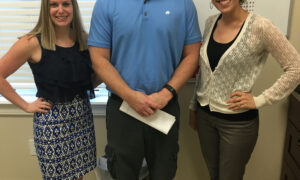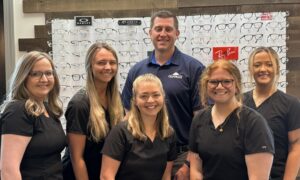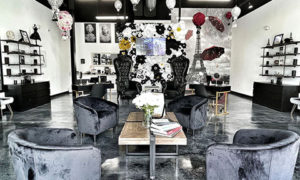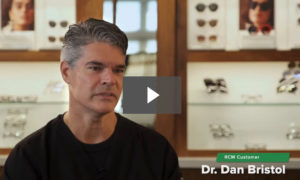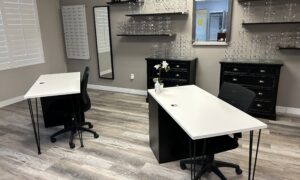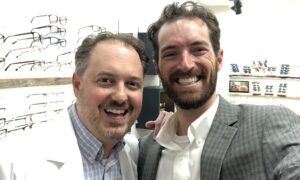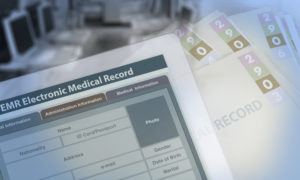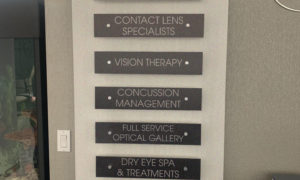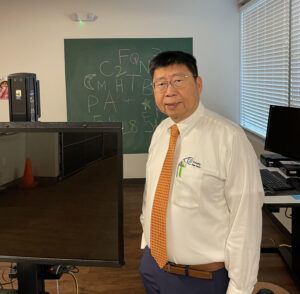
Dr. Pang in one of the rooms where he conducts neuro-rehabilitation services in his practice. He says offering neuro-rehab care is professionally rewarding and a great way to grow your practice.
Setting your practice apart with a much-needed service.
By Albert Pang, OD, FIAO
May 22, 2024
After practicing in a private setting for over 20 years, I realized that some patients came to me with symptoms that could not be treated with traditional refractive correction. Nothing seemed to work, and the usual solutions just weren’t cutting it for these patients.
This was no coincidence. All the patients had common medical histories with concussions and neurological complications, which, in turn, affected their vision.
Because of the several “mystery” problems I saw within my patient pool, it became apparent that I needed to provide these special patients with a neuro-rehab optometry service. I found that the new service I provided solved many of my patients’ symptoms and boosted my practice’s bottom line.
Here’s how I did it, and why it was one of the best investments I made for my practice and my professional career.
What You’ll Need
To accurately diagnose and treat patients, neuro-optometry is a specialty that demands advanced instrumentation that is beyond a typical pre-testing rotation.
I already had a lot of the necessary machinery, which I already used to diagnose and monitor retinal or optic nerve diseases. So, if you already have some, or all, of these machines in your arsenal, you’re well on your way. This included:
- An automated visual field tester
- Optical coherence tomography (OCT)
- ERG and VEP tester
- A retinal camera
The new technology I added to my practice specific to my neurological examination service included:
- Eye tracking devices, such as RightEye
- A Neurolens N3 to measure small amounts of phoria
- Additional handheld devices like prism bars, Maddox rods, loose prism sets, trial frames and Risley prisms.
Additional Education for ODs
Like most specialties, neuro-optometry is a lifelong learning process, and continued education was critical to my success. Luckily, my staff and I got help from many good teachers from various resources.
I took classes from Brenda Montecalvo, OD, and I finished clinical training courses from John Abbondanza, OD, through the Optometric Extension Program Foundation (OEP). I also received training with Deborah Feinberg, OD, from the NeuroVisual Medicine Institute in Michigan.
Every year, I attend other courses offered by the College of Optometrists in Vision Development (COVD) as well as OEP, to stay up to date with diagnostic and rehabilitation procedures.
Additional Training for Your Support Staff
I found that many of my neurovisual patients had a lot of questions, and they often suffered for many years, visiting multiple specialists.
Other Articles to Explore
It is important to have a dedicated staff member to spend time with patients, effectively and accurately explaining the treatment we provide, and setting expectations, before they come in for a consultation. You need to have someone who is compassionate and patient for that. Therefore, it’s important to provide proper training for your staff.
I was fortunate enough to have one of my staff members come with me to train at the NeroVisual Medicine Institute. She became my neurovisual patient advocate. I also had a dedicated staff member frequently attend virtual meetings with me, who eventually became my adviser to neurovisual patients.
I believe COVD and OEP provide exceptional staff training in neuro-rehabilitative procedures.
Build Co-Managing Relationships with Other Healthcare Practitioners
It is a team effort to help this special group of patients.
To ensure the best outcomes for your patients, you will need a team of professionals to coordinate care with. This team should include neurologists, vestibular therapists, vestibular specialists, occupational therapists, psychologist, neuro-otologists, psychiatrists and craniosacral therapists.
In addition, I found that sometimes attorneys have to get involved to fight for our patients’ legal rights.
Manage Your Schedule to Give Neuro-Rehab Patients Adequate Time & Attention
It takes time to examine neuro-rehab patients, and you will need to give them breaks during their examination.
Therefore, allocating enough time to examine these patients is vital, as it probably takes 2-3 hours to fully examine them in the initial consultation.
I cannot stress enough how important it is to be patient with those who come in for neuro-rehab treatment. Special cases will often require the sincerest effort from you and your staff.
Manage Needed Expenses
Cost: The cost to my practice of getting ready to serve neuro-rehab patients was roughly $17,000, which went directly toward the purchase of necessary technology and machinery. However, if you don’t already have an OCT, automated visual field tester and retinal camera, your initial investment may be more costly than mine.
I don’t see myself as the greatest businessman, but in my many years of experience, I found that when you care about your patients you will be rewarded many times over. And this rang true in the investment I made to begin providing neuro-rehab services.
ROI: I was able to recoup my investment within the first year, not including the added referrals from the patients suffering from neuro-related optical conditions, which, if you add those patients in, allowed me to recoup my investment even faster.
Market Your Neuro-Rehab Services
One of the most important parts about making your money back on your investment, and a good ROI, is properly marketing your practice’s neuro-rehab services. I found that referrals from both professional and patient sources were critical to my practice’s success. Simply put, word-of-mouth referrals worked like a charm.
We contracted with a physician liaison to visit different optometrists, as well as other medical specialists (physical medicine specialists, occupational therapists, physical therapists, neurologists, ENT, vestibular specialists, ophthalmologists and chiropractors).
The physician liaison came to my office to observe how we examined our patients, the optical devices we used to treat our patients and the rehabilitative procedures we performed.
The liaison also listened to my staff’s interaction with my patients and how my patients talked about their results from our treatments (again, reiterating the importance of a well-trained staff). He then represented us by visiting different possible referral sources and asking them for referrals to our practice.
The Importance of Specializing
To close, I’ll leave you with this. Whether you specialize in neuro-optometry, or you choose to invest in something else, specializing is vital to the success of any optometric practice.
Neuro-optometry sets me apart from every practice in my area, allowing me to make a true difference in my community.
I am fortunate to have been involved in this specialty. Seeing my patients transform in my practice every day is the biggest reward to me. It is such a good feeling to see patients able to read, walk and pursue their dreams again.
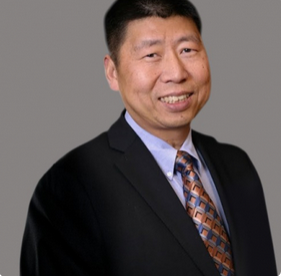 Albert Pang, OD, FIAO, practices at Trinity Eye Care in Plano, Texas. The practice is part of the AEG Vision family. To contact Dr. Pang: apang@eyecarespecialtiestx.com.
Albert Pang, OD, FIAO, practices at Trinity Eye Care in Plano, Texas. The practice is part of the AEG Vision family. To contact Dr. Pang: apang@eyecarespecialtiestx.com.



